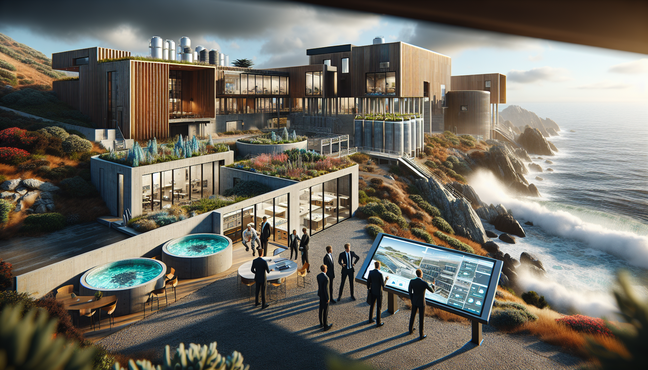Introduction to Water Treatment Plant Renovations
Renovating water treatment plants is crucial for ensuring clean and safe drinking water, especially as existing infrastructures age and face new challenges. Modernization of these facilities plays a pivotal role in meeting stringent public health and environmental standards set by regulatory bodies. It helps integrate advanced technologies, such as automated systems and real-time monitoring tools, which enhance operational efficiency and response times during emergencies.
Furthermore, upgrades allow for better treatment processes that effectively remove contaminants and adapt to changing water quality as a result of climate change and urbanization. By investing in renovation, municipalities can reduce operational costs, improve water quality, and prolong the lifespan of their facilities, all while safeguarding community health. Studies have shown that modernized plants lead to a significant reduction in compliance violations, showcasing the direct link between infrastructure investment and public health outcomes [Source: EPA].
Challenges Faced in Aging Infrastructure
Outdated water treatment plants face numerous challenges that compromise their effectiveness and sustainability. One of the most pressing issues is compliance with evolving regulations. As environmental standards tighten, many plants struggle to meet the updated legal requirements, risking fines and operational shutdowns if they fail to comply [Source: EPA].
Efficiency concerns also plague aging facilities. Older treatment plants typically use outdated technology and processes that are less effective at removing contaminants. This not only leads to reduced water quality but can also result in higher operational costs due to energy inefficiency. Innovative technologies, such as membrane filtration and advanced oxidation processes, can significantly enhance treatment effectiveness; yet many plants are unable to afford these upgrades [Source: Water Online].
Moreover, the environmental impact of outdated infrastructure cannot be ignored. Many aging plants discharge effluents that do not meet current ecological standards, contributing to waterbody pollution and harming aquatic ecosystems. The necessity for renovation becomes evident when considering that improved infrastructure can lead to better water quality and reduced long-term environmental impacts [Source: NRDC].
Ultimately, addressing these challenges through rehabilitation and modernization is not just beneficial but essential for sustainable water management, public health, and environmental protection [Source: Construction Solution Inc].
Key Technologies Transforming Water Treatment
In recent years, the water treatment industry has undergone a significant transformation due to the introduction of key technologies designed to enhance efficiency, sustainability, and effectiveness. Here are some of the most impactful innovations reshaping the sector:
1. **Smart Sensors**: The integration of IoT-based smart sensors enables real-time monitoring of water quality parameters such as pH levels, turbidity, and temperature. These sensors provide timely data analytics, allowing operators to make informed decisions and swiftly address any potential contamination issues. Such proactive measures are crucial in ensuring safe drinking water and compliance with regulatory standards [Source: ScienceDirect].
2. **Advanced Filtration Techniques**: Technologies such as membrane filtration, including reverse osmosis and ultrafiltration, are gaining traction for their efficiency in removing contaminants at the molecular level. These techniques not only enhance water purity but also reduce the need for chemical treatments, minimizing environmental impact. According to research, membrane processes can reduce water treatment costs while improving the quality of treated water [Source: WaterWorld].
3. **Energy-Efficient Systems**: The development of energy-efficient water treatment systems is critical for reducing operational costs and minimizing carbon footprints. Innovations such as solar-powered desalination and energy recovery from wastewater treatment processes showcase how the industry can harness renewable energy sources. These methodologies can significantly decrease energy consumption, making water treatment more sustainable [Source: Hydronic Hemp].
4. **Automated and AI-driven Solutions**: The use of artificial intelligence and machine learning is transforming water treatment operations by optimizing processes and predicting maintenance needs before issues arise. Automated systems can control chemical dosing, adjust filtration rates, and manage energy use based on real-time data, leading to improved operational efficiency and lower costs [Source: Water Online].
5. **Advanced Oxidation Processes (AOPs)**: AOPs leverage powerful oxidizing agents to break down organic pollutants in water. Technologies such as ozone and advanced oxidation utilize UV light and hydrogen peroxide to achieve high levels of degradation for stubborn contaminants. AOPs are particularly effective for treating industrial wastewater, making them a vital tool for modern water treatment [Source: NCBI].
Understanding and adopting these cutting-edge technologies is essential for water treatment facilities aiming to modernize their operations and meet the rising demand for clean water while addressing environmental concerns. For further insights on water treatment innovations, explore our article on [sustainable water practices](https://constructionsolutioninc.com/sustainable-water-practices).
The West Coast Renovation Case Study
The renovation of the West Coast water treatment facility, completed in 2023, aimed to enhance operational efficiency and sustainability while meeting increasing water quality standards. The project’s primary goals included upgrading aging infrastructure, reducing energy consumption, and improving the overall reliability of water treatment processes.
To achieve these goals, the project employed several innovative strategies. First, a comprehensive energy audit was conducted to identify areas for improvement. Based on this audit, the project team installed energy-efficient pumps and motors, which led to a remarkable 30% reduction in energy usage. Additionally, advanced filtration systems were integrated to enhance water purification efficiency and comply with stricter regulatory requirements [Source: WaterWorld].
The renovation also prioritized sustainable practices. The facility introduced a rainwater harvesting system that captures and stores rainwater for non-potable uses, reducing the demand on municipal water supplies by approximately 20%. Furthermore, the project utilized environmentally friendly materials and reduced construction waste through a rigorous recycling plan, aligning with green building standards [Source: EPA].
Measured outcomes of the renovation were positive. Post-renovation analyses showed a 15% improvement in water quality indicators, and operational costs diminished by 25% annually. These results not only showcased the renovation’s efficiency but also underscored the importance of proactive infrastructure investment in maintaining public health and safety [Source: Journal of Public Diplomacy].
Through this case study, stakeholders can glean valuable insights into the intricacies of large-scale water treatment facility renovations, emphasizing the integration of technology, sustainability, and cost-effectiveness throughout the planning and implementation phases. For more detailed exploration of similar projects, visit our comprehensive analysis on various construction solutions [here](https://constructionsolutioninc.com).
Future of Water Treatment: Trends and Predictions
The future of water treatment is poised for significant transformation driven by technological advancements, sustainability initiatives, and evolving government policies. Key trends shaping this landscape include increased investment in advanced treatment technologies, such as membrane bioreactors and AI-driven monitoring systems, which enhance efficiency and reduce operational costs. Notably, technologies like UV disinfection and advanced oxidation processes are gaining traction, offering effective pathogen removal while minimizing chemical usage [Source: Water Tech Online].
Government policies are aligning with sustainability goals, emphasizing the need for resilient water management strategies that prioritize conservation. This includes the promotion of decentralized treatment systems, which can reduce the burden on centralized plants and enable localized water reuse, thereby integrating sustainability into urban planning [Source: EPA]. Furthermore, regulatory frameworks are increasingly incentivizing the adoption of green infrastructure solutions, such as green roofs and rain gardens, which can mitigate stormwater runoff and improve water quality.
Another notable trend is the integration of smart technologies in water management. The Internet of Things (IoT) is facilitating real-time data collection and analytics, allowing for predictive maintenance and enhanced operational decision-making. This shift towards data-driven approaches not only optimizes resource use but also empowers utilities to respond proactively to emerging water quality issues [Source: Wall Street Journal].
As we look ahead, the water treatment industry will likely continue to evolve, focusing on minimizing environmental impacts while ensuring access to clean water for future generations. Collaborations among governments, industries, and research institutions will be crucial in fostering innovation and implementing effective solutions that address the increasing challenges of water scarcity and quality. Emphasizing sustainability, efficiency, and technology integration will define the next era of water treatment, making it more resilient to the demands of a changing world and enhancing the overall health of our communities.






